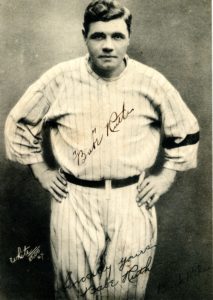 Coming to Johnstown, PA, on July 26, 1927, the New York Yankees were flying high. They had a record at this point in the season of 67-26-1 and had won their previous two games against the Chicago White Sox. The legendary Murderer’s Row, the hard-hitting starting Yankee’s line-up that included Babe Ruth, Lou Gehrig, Tony Lazzeri, Bob Meusel, and Earle Combs, led the team. Ruth would hit 60 home runs in 1927, which is a record that would stand for 34 years. Gehrig would finish the season with 175 runs batted in. Many fans and baseball historians consider the 1927 Yankees the best baseball team of all time.
Coming to Johnstown, PA, on July 26, 1927, the New York Yankees were flying high. They had a record at this point in the season of 67-26-1 and had won their previous two games against the Chicago White Sox. The legendary Murderer’s Row, the hard-hitting starting Yankee’s line-up that included Babe Ruth, Lou Gehrig, Tony Lazzeri, Bob Meusel, and Earle Combs, led the team. Ruth would hit 60 home runs in 1927, which is a record that would stand for 34 years. Gehrig would finish the season with 175 runs batted in. Many fans and baseball historians consider the 1927 Yankees the best baseball team of all time.
So it was big news when the Yankees arrived in Johnstown to play baseball.
“Johnstown baseball fans who attend the big exhibition game between the New York Yankees and the Johnstown Middle Atlantic Leaguers in the Point Stadium Monday are certain to see the greatest exhibition of hitting ever witnessed in this city,” the Johnstown Tribune reported.
Of course, the players on the Johnstown Johnnies, the city’s Middle Atlantic League, probably expected to get thoroughly thumped. Although the team had won the league championship the year before, they were still a class C team going up against a team that the New York Times said, had “pretty much clinched the American League pennant.”
The game became more than a simple exhibition game. It was a Johnstown event.
“Monday, July 25 has been designated as Babe Ruth day in Johnstown and business will be at a standstill in order that every person may honor the hardest hitting ball club in the history of the national pastime,” the Indiana Evening Gazette.
Tickets for the game at the year-old Point Stadium sold for $1.10 to $1.65. Besides the game, a boxing match was featured beforehand.
Ruth was known to have a special connection with children, and they, in turn, loved him. Often at games while warming up, he would throw a pitch to his catcher, catch the return throw, and then toss the ball to a kid in the crowd that inevitably gathered around him.
Things were no different in Johnstown. “Ruth proved himself a genial fellow and was glad to shake the hand over every kid who could get near him,” the Johnstown Tribune reported. “He visited the local hospitals yesterday morning. From the time of the arrival of the New York club in this city until its departure, Ruth was the center of attraction.”
Throughout his time in the city, he was swamped by fans who wanted him to autograph their baseballs or programs. An estimated 10,000 people packed the stands that night to watch the game.
While 1927 might have been the Yankee’s year, July 25 was not their night. Johnstown’s Nat Hickey and Lafe Byard hit home rooms in the first and second innings with two runners on base each time. They gave the Johnnies a lead the Yankees couldn’t overcome. Ruth had five chances at bat, but he couldn’t get on base until the ninth inning when he hit a double into the right field stands.
For years, it was argued whether Ruth hit a home run during the game. Mike Mastovich at the Johnstown Tribune-Democrat put that to rest a few years ago, writing, “In those days, a ball hit into the seats in the short right field section of the original Point was ruled a double instead of a homer.”
The belief that Ruth hit a home run might also come from the fact that in another exhibition game against the Johnnies in June 1928, both Ruth and Gehrig hit two home runs each to win 12-7. The Baltimore Sun said of Ruth’s performance that game, “Ruth’s hits cleared the right-field fence, a feat that has been accomplished by no other player.”
That game was still 11 months in the future. On July 25, 1927, the Yankees lost to the Johnstown Johnnies 7-5.
The pain of losing was quickly soothed the next day when the Yankees won both games in a doubleheader against the St. Louis Browns.
The Yankees finished the 1926 with a 110-44 record, winning the American League Pennant by 19 games. They then went on to sweep the Pittsburgh Pirates in the World Series 4-0.
You might also enjoy these posts: